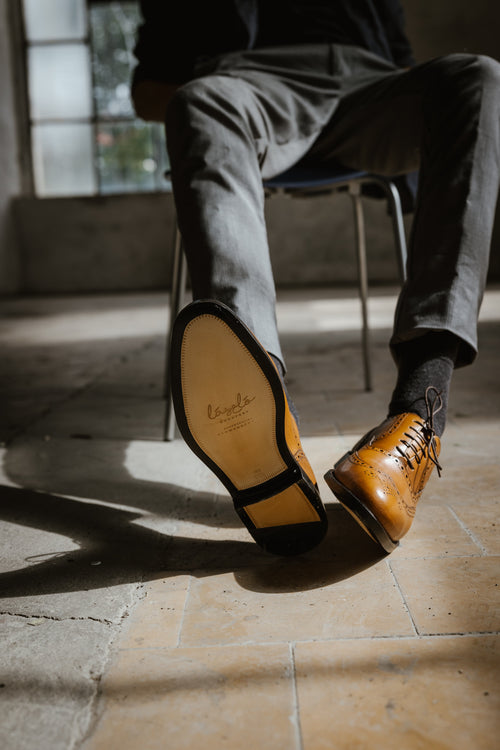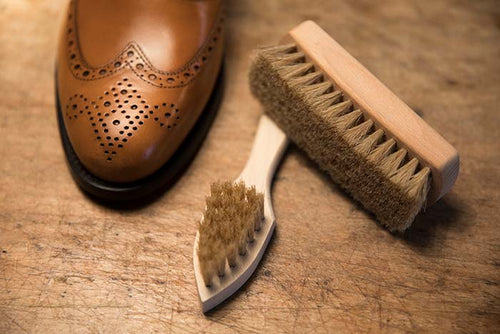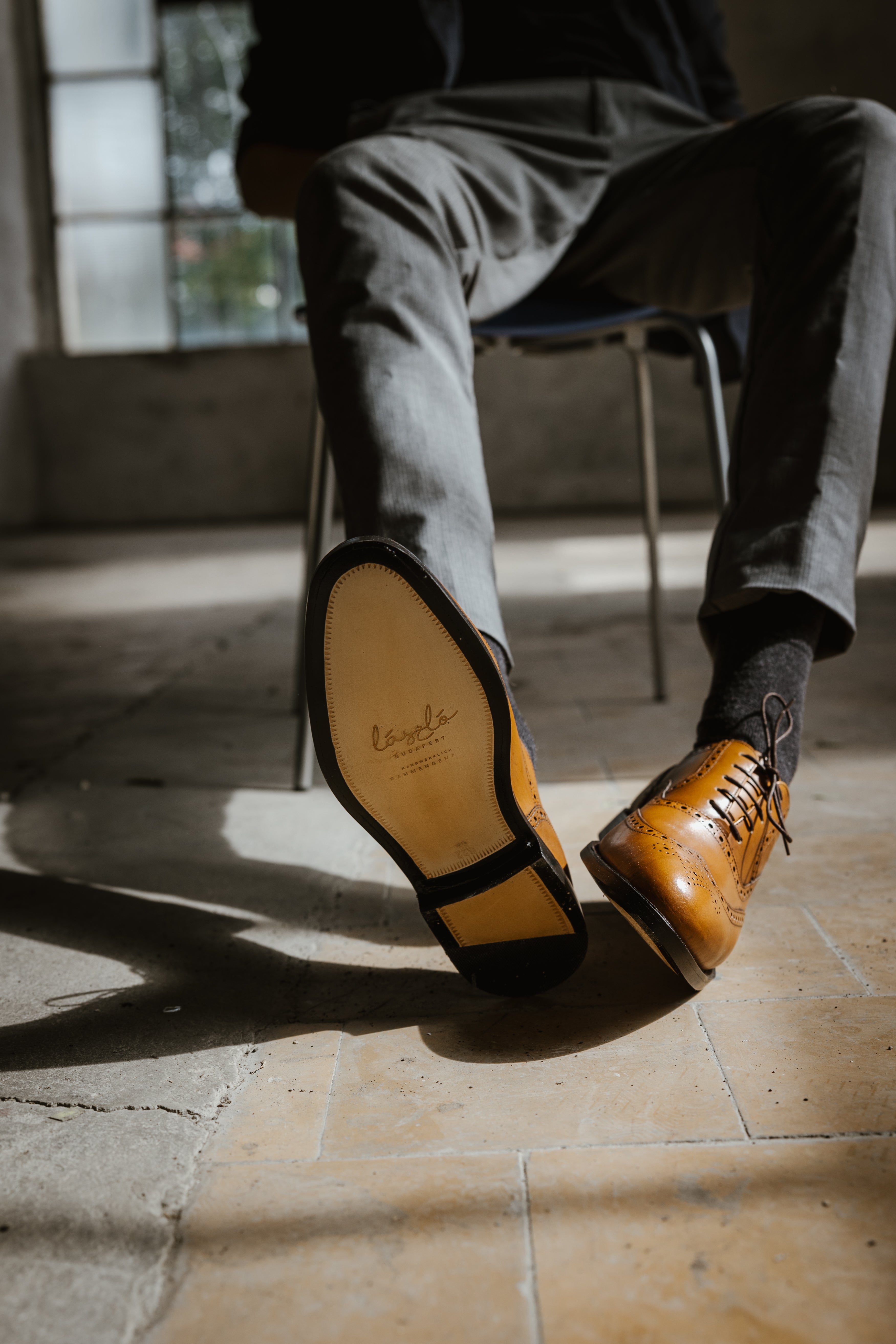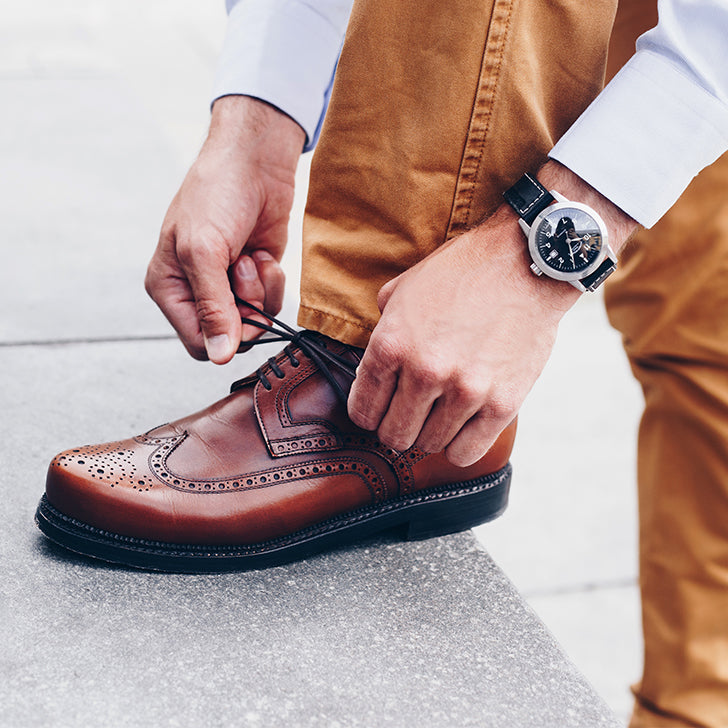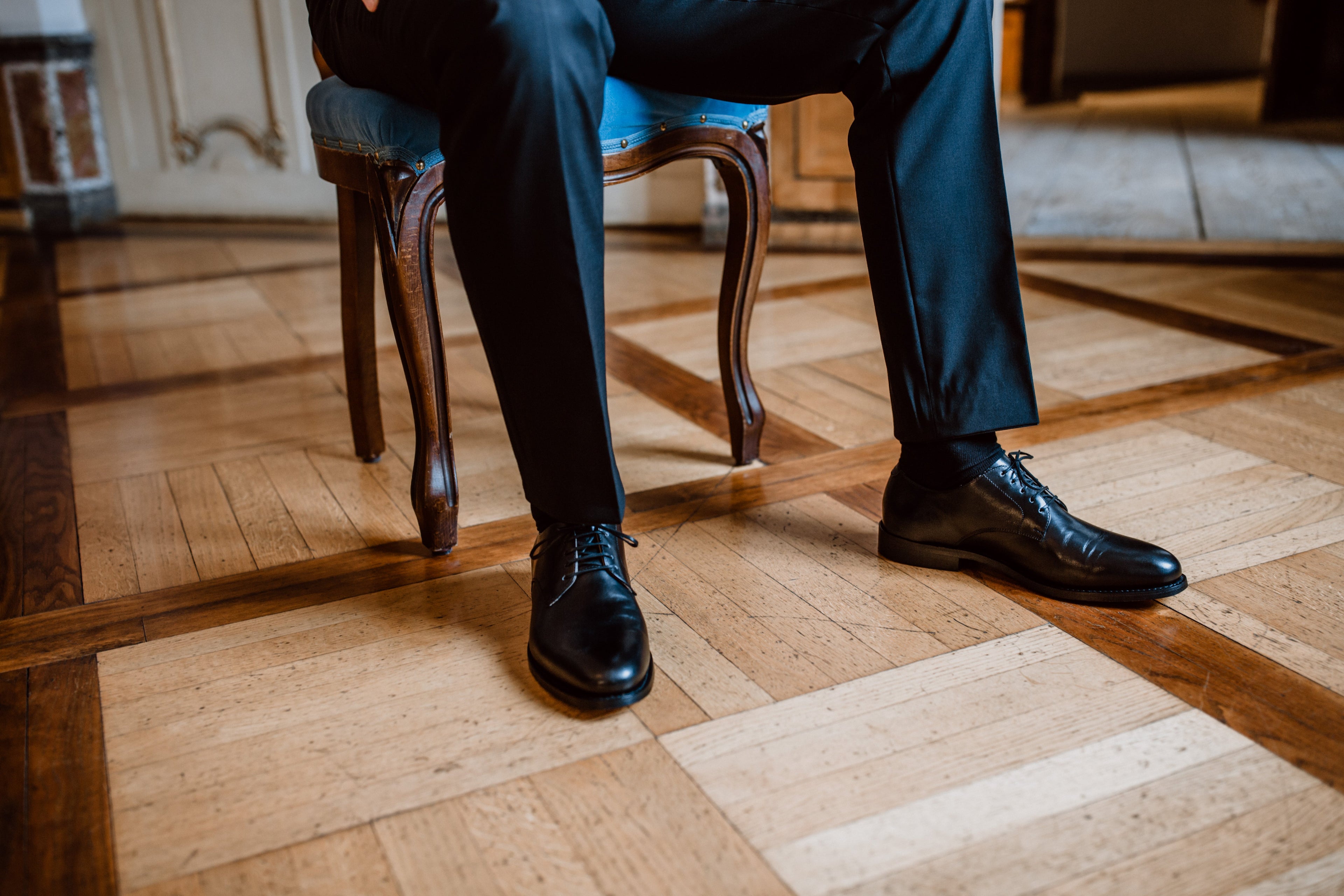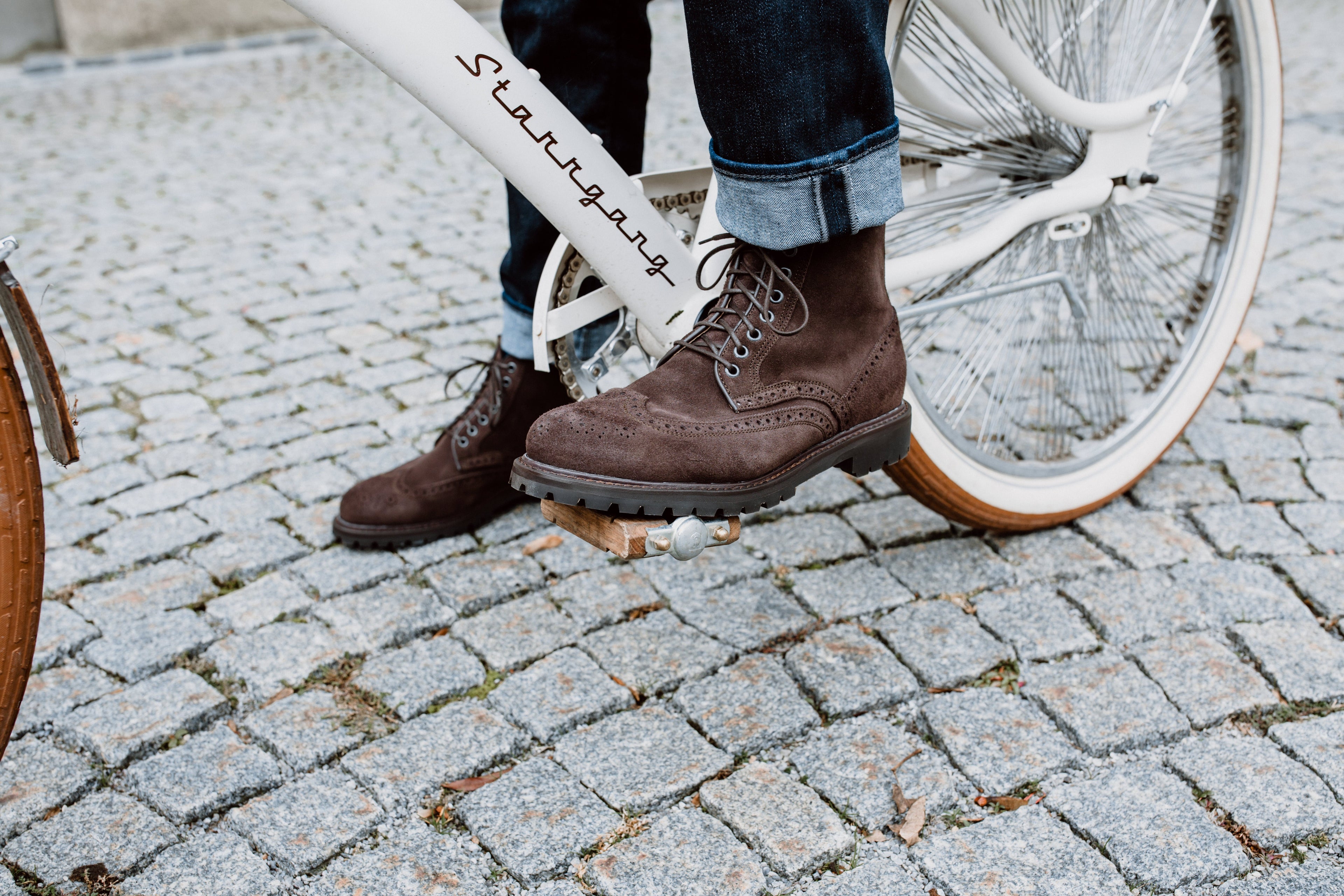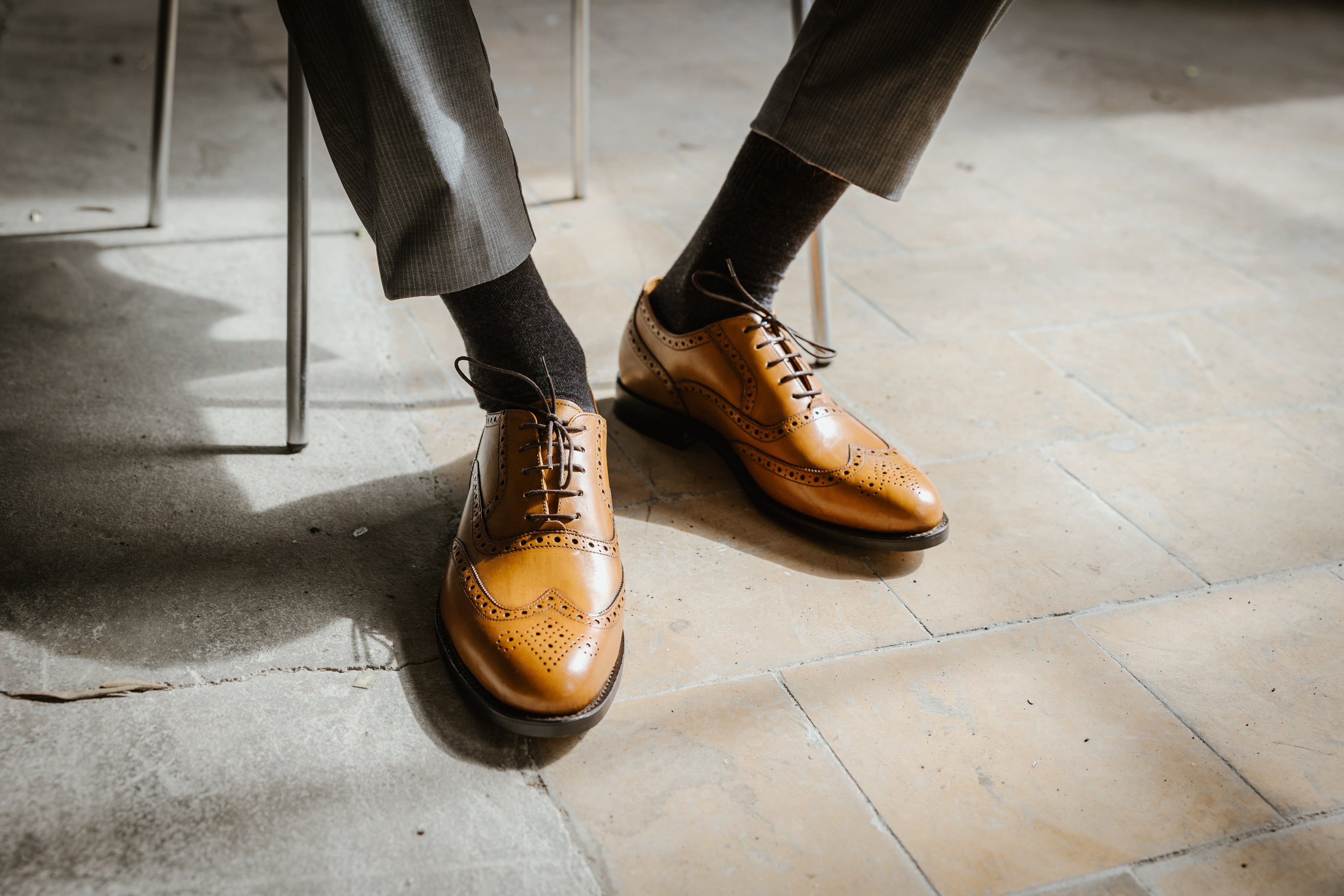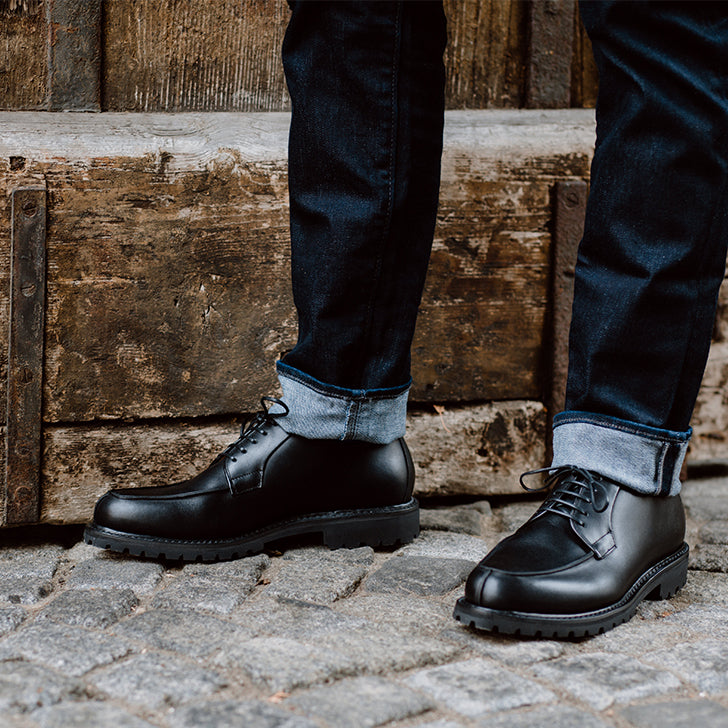Wissenswertes über klassische Herrenschuhe

Modelle - Schuhe mit Eigenschaften
Jeder klassische Herrenschuh wird auf zwei Hierarchie-Ebenen beschrieben und definiert.
Die übergeordnete Kategorie ist die Gattungsbezeichnung. Derzufolge ist ein Schuh ein Brogue, Oxford, Wholecut oder ähnliches. Das nennt man üblicherweise auch das Modell. Zugleich sind mit dem Modell immer auch bestimmte Formen des Einstiegs (Schnürung) als integraler Bestandteil festgelegt. So öffnet ein Brogue immer über einen Blattschnitt. Während ein Blucher ohne Derbyschnitt (auch Derbyschnürung) kein Blucher ist.
Als untergeordnete Spezifizierungen kommen weitere Zuschreibungen wie Plain, Captoe, Full oder Half (Semi) hinzu. Sie beschreiben ein Modell durch ergänzende Attribute, dabei innerhalb seiner Modellgruppe. Man kann diese Zuschreibungen auch als Arten innerhalb einer Gattung verstehen.
So gibt es beispielsweise einen „Plain Oxford“ und einen „Oxford Captoe“. Beide Varianten bleiben Oxford-Modelle. Dabei ist die sprachliche Reihenfolge von Modell und Attribut unwesentlich und Gewohnheitssache, solange man die Hierarchie im Kopf behält.
Kleine Modellkunde - Jedem Anlass der seine
Oxford
Der Oxford ist der formellste unter den klassischen Herrenschuhen und zugleich enorm vielseitig. Mit geschlossenem Blattschnitt und wenigen Teilungsnähten hat er eine besonders zurückhaltende Ausstrahlung. Das macht ihn zum perfekten Schuh für Business-Anlässe, bei denen Sachlichkeit nicht als Mangel an Individualität gilt, sondern als Ausdruck von Seriosität und Selbstbewusstsein.
Daneben kann Mann im Oxford auch stilvoll feiern. Hier ist er der Schuh der Wahl für Festlichkeiten, zu denen ein dunkler Anzug erwartet wird. Sportlicher Kleidung mit Jeans, Chinos und Polohemd gibt der Oxford andererseits eine Extraportion Klasse.
Um die Entstehung des Oxford ranken sich Legenden. So heißt es, dass englische Studenten der Universität Oxford dieses Modell Mitte des 19. Jahrhunderts populär gemacht haben sollen. Aus dem Biedermeier kennen wir ähnlich geschnittene flache Damenhalbschuhe aus feinem Glacéleder. Eine Übernahme des Looks durch jugendliche Snobs in einem Akt von youthcultural appropriation erscheint daher nicht völlig unwahrscheinlich.
Der Plain Oxford zeigt mit glattem nahtlosem Vorderblatt höfliche Reserviertheit. Nur die Seitennähte verbinden das Blatt und die Quartiere. Weitere Teilungsnähte und Verzierungen fehlen.
Beim Oxford Captoe (Modell Henry) teilt eine Naht quer zum Zehenbereich das Vorderblatt des Schuhs. Diese Kappe strukturiert die Fläche und verkürzt so optisch den Fuß.

Brogue
Der Brogue verdankt seine große Bekanntheit der markanten Lochmusterung (engl. Broguing). Diese umfasst beim Fullbrogue die Flügelkappemit der Lyra (Lochmuster-Ornament), sowie den schmalen Lochmusterstreifen an den Rändern von Fersenkappe und Quartieren. Schnitttechnisch kennzeichnet den Brogue ein Blattschnitt (Oxford-Schnürung). Geprägtes, statt glattem Leder und eine Doppelsohle können den sportlich-rustikalen Charakter dieses vielseitigen Schuhkklassikers weiter unterstreichen.
Bis vor hundert Jahren war der Brogue ein Wochenend- und Freizeitschuh mit Stil. Heute ist er das immer noch, begleitet aber inzwischen auch Anzug und sportliche Kombinationen. Nur bei Black-Tie-Anlässen und solchen, die es einmal waren, wie Oper, Theater, Hochzeiten und Begräbnissen, sollte man Lochmuster bestenfalls in homöopathischer Dosierung, also als Quarterbrogue, ausführen.
Die Geschichte des Schuhs wird üblicherweise mit einer Legende erklärt. Danach sollen Schotten und Iren als Drainage-Vorrichtung Löcher in ihre bäuerlichen Treter gebohrt haben, um Schuh und Fuß nach dem sonntäglichen Weg durchs Hochmoor und vor dem Betreten der Kirche trocken zu legen. Wirklich wahrscheinlich ist das nicht. Eher dürften die sparsamen Schotten barfuß gelaufen und die Schuhe für die Kirche aufgespart haben. Gleichwohl hält sich die Morast-Erzählung hartnäckig.
Der Fullbrogue (Modell Edward) verbindet die Lyra-Flügelkappe klassischerweise mit einer Fünf-Loch-Schnürung. Modische Varianten können die Zahl der Schnürlöcher variieren. Als Faustregel gilt, je markanter die Löcher, um so strukturierter die Oberfläche, desto sportlicher der Schuh.

Der Halfbrogue zeigt eine glatt abgesteppte Kappe im Stil des Captoe anstelle der Flügelkappe. Das Lochmuster auf der Kappe ist üblicherweise ornamentaler und kleinteiliger als beim Fullbrogue. Die Löcher sind merklich feiner.
Der Quarterbrogue sieht einem Oxford Captoe zum Verwechseln ähnlich. Der einzige Unterschied: Ein Lochmusterband entlang den Teilungsnähten (Broguing) wirkt dezent dekoriert. Für das formelle Business und Black-tie-Anlässe ist der Quarterbrogue in schwarzem Boxkalb in der Summe dem Oxford weitestgehend ebenbürtig.

Budapester
Ein Fullbrogue mit Derby-Schnitt wird auch Budapester genannt. Klassischerweise ist der echte Budapester zwiegenäht (Modell István). Das macht ihn im Vergleich zum rahmengenähten Brogue kompakter im Auftritte und im Gebrauch robuster.
Vermutlich kam der Brogue an den Füßen von Engländern schon vor dem ersten Weltkrieg auch nach Ungarn, wo er spontan gefiel und nachgebaut wurde. Mit Derby-Einstieg und zwiegenähter Machart – oft auch über einen ungarischen Leisten gearbeitet – wurde er zugleich fertigungstechnisch den regionalen Gebräuchen angepasst: der Budapester war geboren.

Heute begleitet der ungarische Derby-Fullbrogue weitgehend die gleiche Garderobe wie ein doppelsohliger Brogue. Sein Alleinstellungsmerkmal liegt in seiner überdurchschnittlichen Stabilität und Unverwüstlichkeit, die ansonsten nur Arbeitsschuhe auszeichnet. Von dieser sympathischen Kombination aus Tradition und Bodenständigkeit profitieren vor allem Männer mit kräftiger Statur, die gut angezogen sein wollen, jedoch um dünnsohlige, allzu „feine“ Schuhe eher ein Bogen machen – müssen.
In rahmengenährter Ausführung (Modell Johannes) wirkt den Budapester schlanker und Brogue-ähnlicher und betont seine sportlich-elegante Seite.
Blücher
Der Blücher (Modell Julian) ist kein Schuh für Selbstdarsteller. Stattdessen lieben ihn die Perfektionisten unter den Pragmatikern. Mit gutem Grund: Seine formale Reduktion und der praktische Derby-Schnitt gehorchen äußerster Zweckmäßigkeit. Sogar die Quartiere verbinden nicht das Fersenteil mit dem Vorderblatt, sondern sind – besonders haltbar - auf den einteiligen Schaft aufgesteppt. Diese Optik gibt dem Blücher einerseits stilistische Vielseitigkeit. Im Spektrum von Freizeit bis Easy Business mit Denim, Cord und Khaki passt er zu jedem Outfit. So erklärt sich aber auch seine fast militärische Strenge. Diese wiederum könnte mit seiner Entstehungsgeschichte zu tun haben oder dem, was man sich darüber erzählt.

So soll der preußische Feldmarschall Gebhard Leberecht von Blücher diesen asketischen Schuh zur Zeit der Napoleonischen Befreiungskriege bei seinen Soldaten eingeführt haben. Eine Legende? Fakt ist jedenfalls, dass Napoleons Soldaten vor zweihundert Jahren in einfachsten Derby-Schuhen halb Europa unterwarfen. Von Napoleons Truppen lernen, heißt siegen lernen, mag sich damals auch Blücher gesagt haben – offenkundig nicht ohne Effekt.
Üblicherweise wird ein Blücher über einen körpernahen englischen Leisten gearbeitet. Je mediterraner und schlanker die Form, desto mehr verliert sich das typisch Pragmatische in Richtung Performanz.
Derby
Der Derby teilt mit dem Blücher die zurückgenommene, anpassungsfähige Optik. Mit dem praktischen Derbyschnitt hat er auch denselben hohen Gebrauchswert. Dennoch tritt er mit seitlicher Teilungsnaht ziviler auf, ohne seine Uniform-Nähe gänzlich abzulegen. Das ist nicht notwendig militärisch gemeint. Architekten etwa sind natürlicherweise Uniform-affin, indem sie auch bei Kleidung (dunkler Anzug) und Schuhen (Derby) häufig solide Konstruktionen bevorzugen und ihre Zeit lieber in ihre Arbeit investieren als in das persönliche Styling.
Auch beim Derby variiert der Charakter dieses Schuhs durch Leistenform und Farbe. Körpernahe Formen in dunklem Leder wirken klassischer, gestreckte mediterrane Formen in hellen Tönen betonen die modische Innovation.
Der quintessentielle Derby ist der Plain Derby (Modell George). In seiner konsequenten Schmucklosigkeit hat er sich seit hundert Jahren nicht verändert, weil er sich unverändert bewährt. Never change a winning style.
Ein Derby Captoe kann sich mit dem Broguing-Muster an den Rändern von Vorderkappe, Quartieren und Fersenkappe (Modell Alessio) auf den ersten Blick einem eleganten Quarterbrogue annähern. Mit Derbyschnitt und zwiegenähter Doppelsohle wird eine Verwechslung unmöglich, und die größere Bodenständigkeit tritt unmissverständlich in Erscheinung.

Wholecut
Ein Wholecut ist ein Schuh, der auffällt. Weil er anders ist und weil an ihm so wenig „dran“ ist – vermeintlich. Anders als der Laie meint, ist er aber keineswegs ein besonders „einfacher“ Schuh. Im Gegenteil: Für seinen Schaft aus einem Stück muss zum Einen das verarbeitete Leder fehlerlos sein. Denn nichts lässt sich kaschieren. Außerdem verlangt seine Herstellung enorme Geschicklichkeit, um den Schaft plastisch über den Leisten zu ziehen und ohne Überdehnung oder Faltenbildung zu formen. Deswegen sieht man dem Wholecut seine Qualität auch auf einen Blick an – bei den nötigen Vorkenntnissen. Wer sich diese aber aneignet, wird mit diesem Schuh viel Freude haben.

Je nach Sohlenstärke passt sich der Wholecut diplomatisch seiner Umgebung an. In doppelsohliger zwiegenähter Ausführung (Modell Francesco) zieht es ihn zu einer hochwertigen Freizeitgarderobe mit Hang zu traditionellen Styles. Andererseits vermag er auch moderne Dandys zu begeistern. Dunkler getönt und auf einfacher Ledersohle begleitet er dagegen auch Anzüge oder einen Navy-Blazer und kann sich bis auf ein Parkett vorarbeiten, auf dem auch der hochelegante Quarterbrogue zu Hause ist. Kurz, ein großartiger Schuh für Kenner und Entdecker und solche, die es werden wollen.
Verschlussarten – Lass mich rein
Der Einstieg, meist verbunden mit einer Schnürung, entscheidet maßgeblich über Stil und Charakter eines Schuhs. Dabei lassen sich, historisch entwickelt, verschiedene Ausführungen unterscheiden.
Blattschnitt | Balmoralschnürung
Die Quartiere des Schuhs liegen unter dem Vorderblatt des Schuhs und sind damit am einen Ende fixiert. Damit lässt sich ein Schuh mit Blattschnitt, auch Balmoralschnürung genannt, nur mäßig weit öffnen. Zugleich begrenzt der Blattschnitt die Möglichkeit, über die Schnürung den Sitz zu regulieren. Für hochformelle Modelle wie der Oxford und Quarterbrogue ist der Blattschnitt integraler Bestandteil – bei klassischerweise fünf Schnürösen.
Derbyschnitt
Die Quartiere des Schuhs liegen über dem Vorderblatt und lassen sich wie die Türen eines Schrankes weit öffnen.
Dieser Einstieg gibt dem Schuh einen sportlichen, informellen Charakter. Daneben eignet sich der Derbyschnitt für Füße mit hohem Spann. Der Einstieg ist bequem, und die Schnürung lässt sich dem Fuß optimal anpassen.
Wholecut-Schnürung
Das Vorderblatt wird durch einen mittigen (bei Haferlmodellen auch seitlichen) Einschnitt geöffnet. Klassische Quartiere im Sinne separater Schnittteile fehlen. Wie beim Blattschnitt lässt sich der Schaft nur einseitig bewegen, der mögliche Radius beim Öffnen ist damit begrenzt.
Eine Wholecut-Schnürung reicht historisch bis ins frühe Mittelalter zurück und transportiert damit ein Stück Geschichte bis in unsere Gegenwart.
